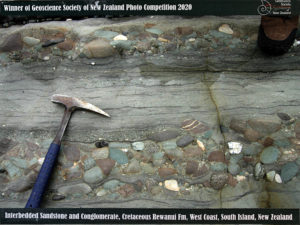There is a certain similarity between rocks and photography. I suppose it has to do with stopping time.
When I look at an outcrop of sediment, whether it is from the Quaternary or the Cambrian, it is like a snapshot of time for me, frozen, and waiting for interpretation. When I take a photo, I am always looking to invoke the feeling I am having with the subject of my lens. It might be a fleeting emotion or something I’ve long been attached to.
But when I go back and look at that photograph it brings back that feeling – like opening a tent after many months and smelling the leaves and sticks and soil that were caught up in there and instantly remembering the place and time I last went camping. Or, more importantly, the feeling I had while on that adventure.
And so with the photograph that recently won first place in the “Milankovic: Geological Cyclicity”
category of the Geoscience Society of New Zealand photography contest brings back a double set of connections. Firstly, it takes me back to the time when I took the photograph – on the West Coast of the South Island doing geology. A cool, windy day, wet but not down pouring and with a van full of students. The smell of damp bush and the sea.
It also takes me back 70 million years, to when the subject of the photo was deposited (the Rewanui Formation). I imagine the streams and fans and Cretaceous vegetation and animals around at that time; I wonder what weather those sediments experienced and how fresh the water was. I think about the sounds back then and how they would have been so familiar, yet heightened without the noises of mankind.
Photography of geology is like one of those infinity mirrors that my son loves; ever enticing, ever mesmerising, hypnotising and strangely satisfying.




Comments are closed.